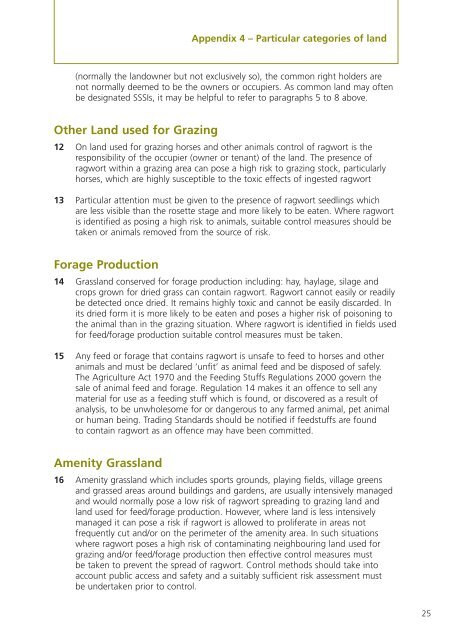code of practice on hopw to prevent the spread of ragwort - Defra
code of practice on hopw to prevent the spread of ragwort - Defra
code of practice on hopw to prevent the spread of ragwort - Defra
You also want an ePaper? Increase the reach of your titles
YUMPU automatically turns print PDFs into web optimized ePapers that Google loves.
(normally <strong>the</strong> landowner but not exclusively so), <strong>the</strong> comm<strong>on</strong> right holders are<br />
not normally deemed <strong>to</strong> be <strong>the</strong> owners or occupiers. As comm<strong>on</strong> land may <str<strong>on</strong>g>of</str<strong>on</strong>g>ten<br />
be designated SSSIs, it may be helpful <strong>to</strong> refer <strong>to</strong> paragraphs 5 <strong>to</strong> 8 above.<br />
O<strong>the</strong>r Land used for Grazing<br />
12 On land used for grazing horses and o<strong>the</strong>r animals c<strong>on</strong>trol <str<strong>on</strong>g>of</str<strong>on</strong>g> <strong>ragwort</strong> is <strong>the</strong><br />
resp<strong>on</strong>sibility <str<strong>on</strong>g>of</str<strong>on</strong>g> <strong>the</strong> occupier (owner or tenant) <str<strong>on</strong>g>of</str<strong>on</strong>g> <strong>the</strong> land. The presence <str<strong>on</strong>g>of</str<strong>on</strong>g><br />
<strong>ragwort</strong> within a grazing area can pose a high risk <strong>to</strong> grazing s<strong>to</strong>ck, particularly<br />
horses, which are highly susceptible <strong>to</strong> <strong>the</strong> <strong>to</strong>xic effects <str<strong>on</strong>g>of</str<strong>on</strong>g> ingested <strong>ragwort</strong><br />
13 Particular attenti<strong>on</strong> must be given <strong>to</strong> <strong>the</strong> presence <str<strong>on</strong>g>of</str<strong>on</strong>g> <strong>ragwort</strong> seedlings which<br />
are less visible than <strong>the</strong> rosette stage and more likely <strong>to</strong> be eaten. Where <strong>ragwort</strong><br />
is identified as posing a high risk <strong>to</strong> animals, suitable c<strong>on</strong>trol measures should be<br />
taken or animals removed from <strong>the</strong> source <str<strong>on</strong>g>of</str<strong>on</strong>g> risk.<br />
Forage Producti<strong>on</strong><br />
14 Grassland c<strong>on</strong>served for forage producti<strong>on</strong> including: hay, haylage, silage and<br />
crops grown for dried grass can c<strong>on</strong>tain <strong>ragwort</strong>. Ragwort cannot easily or readily<br />
be detected <strong>on</strong>ce dried. It remains highly <strong>to</strong>xic and cannot be easily discarded. In<br />
its dried form it is more likely <strong>to</strong> be eaten and poses a higher risk <str<strong>on</strong>g>of</str<strong>on</strong>g> pois<strong>on</strong>ing <strong>to</strong><br />
<strong>the</strong> animal than in <strong>the</strong> grazing situati<strong>on</strong>. Where <strong>ragwort</strong> is identified in fields used<br />
for feed/forage producti<strong>on</strong> suitable c<strong>on</strong>trol measures must be taken.<br />
15 Any feed or forage that c<strong>on</strong>tains <strong>ragwort</strong> is unsafe <strong>to</strong> feed <strong>to</strong> horses and o<strong>the</strong>r<br />
animals and must be declared ‘unfit’ as animal feed and be disposed <str<strong>on</strong>g>of</str<strong>on</strong>g> safely.<br />
The Agriculture Act 1970 and <strong>the</strong> Feeding Stuffs Regulati<strong>on</strong>s 2000 govern <strong>the</strong><br />
sale <str<strong>on</strong>g>of</str<strong>on</strong>g> animal feed and forage. Regulati<strong>on</strong> 14 makes it an <str<strong>on</strong>g>of</str<strong>on</strong>g>fence <strong>to</strong> sell any<br />
material for use as a feeding stuff which is found, or discovered as a result <str<strong>on</strong>g>of</str<strong>on</strong>g><br />
analysis, <strong>to</strong> be unwholesome for or dangerous <strong>to</strong> any farmed animal, pet animal<br />
or human being. Trading Standards should be notified if feedstuffs are found<br />
<strong>to</strong> c<strong>on</strong>tain <strong>ragwort</strong> as an <str<strong>on</strong>g>of</str<strong>on</strong>g>fence may have been committed.<br />
Amenity Grassland<br />
Appendix 4 – Particular categories <str<strong>on</strong>g>of</str<strong>on</strong>g> land<br />
16 Amenity grassland which includes sports grounds, playing fields, village greens<br />
and grassed areas around buildings and gardens, are usually intensively managed<br />
and would normally pose a low risk <str<strong>on</strong>g>of</str<strong>on</strong>g> <strong>ragwort</strong> <strong>spread</strong>ing <strong>to</strong> grazing land and<br />
land used for feed/forage producti<strong>on</strong>. However, where land is less intensively<br />
managed it can pose a risk if <strong>ragwort</strong> is allowed <strong>to</strong> proliferate in areas not<br />
frequently cut and/or <strong>on</strong> <strong>the</strong> perimeter <str<strong>on</strong>g>of</str<strong>on</strong>g> <strong>the</strong> amenity area. In such situati<strong>on</strong>s<br />
where <strong>ragwort</strong> poses a high risk <str<strong>on</strong>g>of</str<strong>on</strong>g> c<strong>on</strong>taminating neighbouring land used for<br />
grazing and/or feed/forage producti<strong>on</strong> <strong>the</strong>n effective c<strong>on</strong>trol measures must<br />
be taken <strong>to</strong> <strong>prevent</strong> <strong>the</strong> <strong>spread</strong> <str<strong>on</strong>g>of</str<strong>on</strong>g> <strong>ragwort</strong>. C<strong>on</strong>trol methods should take in<strong>to</strong><br />
account public access and safety and a suitably sufficient risk assessment must<br />
be undertaken prior <strong>to</strong> c<strong>on</strong>trol.<br />
25
















